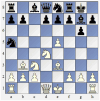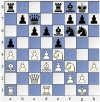Development and validation of the scale of aesthetics and creativity in chess
- PMID: 40519822
- PMCID: PMC12163028
- DOI: 10.3389/fpsyg.2025.1545846
Development and validation of the scale of aesthetics and creativity in chess
Abstract
This study examined the psychometric quality of the Scale of Aesthetics and Creativity in Chess (SACC) with the data collected from 132 expert and non-expert chess players. To analyze the validity, reliability, and item functioning within the scale, the Many-facet Rasch model was applied. The Rasch measure explained 50.59% of the variance in scores and provided evidence for the scale's unidimensionality. The reliability indices for items and participants were 0.83 and 0.93, respectively. The expertise level of chess players predicted scores on the SACC; however, Intermediate level players showed the lowest scores in comparison with Expert, Advanced, and Beginner level participants.
Keywords: Many-facet Rasch model; Rasch analysis; aesthetics; chess; creativity; expertise.
Copyright © 2025 Scherbakova, Engelhard and Bahar.
Conflict of interest statement
The authors declare that the research was conducted in the absence of any commercial or financial relationships that could be construed as a potential conflict of interest.
Figures
Similar articles
-
Development and Validation of the Jawline Subject Satisfaction Scale.Plast Surg (Oakv). 2024 May 13:22925503241249757. doi: 10.1177/22925503241249757. Online ahead of print. Plast Surg (Oakv). 2024. PMID: 39553530 Free PMC article.
-
Rasch Validation of the Mini-BESTest in People With Parkinson Disease.J Neurol Phys Ther. 2022 Jul 1;46(3):219-226. doi: 10.1097/NPT.0000000000000401. Epub 2022 Apr 11. J Neurol Phys Ther. 2022. PMID: 35404882
-
Rasch validation of a new scale to measure dependency in arm use in daily life: the Upper Limb Lucerne ICF-based Multidisciplinary Observation Scale.Front Neurol. 2023 Jul 10;14:1154322. doi: 10.3389/fneur.2023.1154322. eCollection 2023. Front Neurol. 2023. PMID: 37492854 Free PMC article.
-
Rasch Validation of the Arabic Version of the Behavioral Intention to Interact With Peers With Intellectual Disability Scale.Front Psychol. 2019 Oct 16;10:2345. doi: 10.3389/fpsyg.2019.02345. eCollection 2019. Front Psychol. 2019. PMID: 31681124 Free PMC article.
-
Assessing the desire for aesthetics: Adaptation and validation of the desire for aesthetics scale in German (DFAS-G).Acta Psychol (Amst). 2024 Jul;247:104322. doi: 10.1016/j.actpsy.2024.104322. Epub 2024 May 21. Acta Psychol (Amst). 2024. PMID: 38776808
References
-
- Acar S., Burnett C., Cabra J. F. (2017). Ingredients of creativity: originality and more. Creat. Res. J. 29, 133–144. doi: 10.1080/10400419.2017.1302776 - DOI
-
- Amabile T. M. (1982). Social psychology of creativity: a consensual assessment technique. J. Pers. Soc. Psychol. 43, 997–1013. doi: 10.1037/0022-3514.43.5.997 - DOI
-
- Amabile T. M. (1983). The social psychology of creativity: a componential conceptualization. J. Pers. Soc. Psychol. 45, 357–376. doi: 10.1037/0022-3514.45.2.357 - DOI
-
- Andrich D. (1988). Rasch models for measurement. Newbury Park: Sage Publications, Inc.
-
- Baer J. (2012). Domain specificity and the limits of creativity theory. J. Creat. Behav. 46, 16–29. doi: 10.1002/jocb.002 - DOI
LinkOut - more resources
Full Text Sources





